












No matter what your fortunes are, Dr. Daniel will give you the smile you need to make your dreams come true!




PHILLIP TORIELLO






















No matter what your fortunes are, Dr. Daniel will give you the smile you need to make your dreams come true!












Her background in architecture gives San Luis Obispo City Council Member ANDY PEASE a unique perspective on housing.
The duo behind BEAR MARKET RIOT takes their power-folk sound to the stage this summer.
Flowers are in full bloom, dotting the hillsides along the coast. Inspired by the sight, PADEN HUGHES stops by a farm of perhaps the most fragrant of them all—lavender.

While summer is full of sunny skies and warm weather, it’s also just plain full, and is often the busiest time of the year. Read on for the perfect tips to help you relax this season.
Writing a memoir is no easy task, but with insight from New York Times bestselling author FRANZ WISNER, finding the right words just got a whole lot easier.
Setting out on her own, KIMBERLY WALKER treks the 65-kilometer hike through Israel known as the Jesus Trail.
Retired journalists JOHN P. LINDSAY and his wife, LESLIE WARD, welcome us into their modern farmhouse.
In partnership with the American Institute of Architects, we present two top-ranking projects along the Central Coast designed by local architects.

We share the year-to-date statistics of home sales for both the city and the county of San Luis Obispo.
Two arts organizations have plans underway that will dramatically reshape downtown San Luis Obispo.
With a passion fo r politics, Mission College Preparatory High School graduating senior ERIN SPILLANE is excited for the adventures ahead.
Combing their passions for food and drink, JAIME LEWIS and BRANT MYERS join forces in this issue to explore the Central Coast’s best beer pairings.
While some go for the Reuben, others prefer the Rachel. Lucky for us CHEF JESSIE RIVAS breaks down his favorite hot pastrami sandwich recipe.
Summer is upon us and JEANETTE TROMPETER is ready to enjoy live music with our local winemakers.
Looking for something to do? We’ve got you covered. Check out the calendar to discover the best events around the Central Coast in June and July.










The other day, I found myself at a stoplight behind an old Lincoln Town Car. It must have been an ’83 or ’84, maybe an ’85. Many moons have passed since I’ve seen one that old. I smiled to myself as I considered the idea that it might as well have been a time machine idling in front of me.
Most of my years growing up were spent running around the cracked asphalt of Myrtle Street, not far from Highway 198 in Visalia, two-and-a-quarter hours east of here, in the middle of the mighty San Joaquin Valley. The street had no sidewalks, making it ideal for sideline passes during touch football. A never-ending Wiffle Ball game was hosted in our front yard. Directly across the street from the diamond sat a squatty little 1950-something popcorn stucco-covered ranchette. Home runs had to hit the house on the fly to count; if the ball bounced first it was considered a ground rule double. That’s where Jennifer Edwards lived.
Despite the triple-digit summertime heat, we played a lot of baseball. A lot. It was not long before I was crushing everything the neighborhood kids would throw my way. And without fail, every time I nailed a home run I could count on one thing. By the time I rounded second, Jennifer Edwards would be shaking her fist through her front door hollering at us to get off her property and stay away from her flower bed. Some Major League ballparks launch a few quick fireworks when the home team hits one out of the park—the San Francisco Giants blow a foghorn—on Myrtle Street it was our neighbor blowing a fuse. Over time, Jennifer Edwards became my nemesis. Secretly, I loved every minute of it—and, as it turned out, so did she.
I realized early on that having a strong adversary is actually a good thing. Think about it; where would the Giants be without the Dodgers? How about Reagan without Gorbachev? Luke Skywalker would be a no-name farmer in Tatooine if it weren’t for Darth Vader. My rival was Jennifer Edwards. She was tough. Tough as nails. Most of the neighborhood kids were terrified of her—not me. She did everything in her power to break me down, but nothing worked. And it frustrated her to no end. There was not a kid within a one-mile radius that she had not been able to reduce to a soggy, tearyeyed mess. Jennifer Edwards had a reputation around town. You did not mess with her.
It was a car accident in her younger years that left a massive scar on one side of her face that framed what appeared to be an always watching, allknowing evil eye. The word of God was peppered throughout her explosions and she could be counted on to shout out “Praise the Lord!” when things were going her way. But most of the time, because I had trampled her petunias as I retrieved my ball, Jesus would personally see to it that punishment would be an eternity of hellfire and damnation. That was the point where most kids lost it. Not me. I’d start quietly planning my counter attack. Guerilla warfare was the great equalizer, and a steady stream of pranks rolled forth over the years. I was always careful to cover my tracks so that she was unable to pin the transgressions on me. And, I never told any of the other kids what I was up to, not even my younger sisters. But, she knew. And, I knew.
Things came to a head one day when my mom asked her to pick my sisters and me up from school because it was raining and she was stuck at work. As we left Veva Blunt Elementary we were surprised to see Jennifer Edwards roll up in her brand new Lincoln Town Car with its license plate frame that read, “My other car is a broom.” Dutifully, my sisters hopped in. With my Dukes of Hazzard lunch pail in-hand, I started walking. The Lincoln quickly caught up to me, matching my pace. Continuing alongside she rolled her window halfway down to shield the rain, which was beginning to quicken. Once again, I was reminded that the Prince of Peace would be judging harshly. I didn’t care. I kept walking. She kept driving. The whole way home, about a mile-and-a-half, she drove next to me, barking orders the entire time.
The next day, I resolved that the counterstrike would be fierce. I would unleash a level of fury never before seen on Myrtle Street. After pedaling my BMX down to Long’s Drugs and dropping two months’ worth of allowance into the fire engine red coin machine, I returned with a backpack full of plastic eggs. That night, under a cloak of Tule fog, I tiptoed across the street and smeared her entire car with fake snot.
Many years later, long after my Myrtle Street days, I heard that Jennifer Edwards was sick. The news got me thinking back to all of the great adventures growing up, and I realized that my childhood would not have been half as rich as it was if it weren’t for her. I sat down that night and penned a card telling her how much she meant to me all of those years—as well as finally admitting to sliming her car—and how without her I would not have turned out the way I did. A couple of years later she passed away in the old house behind centerfield. And as her family cleaned out her bedroom, standing upright on the nightstand next to her bed, they found my card.
I would like to take this opportunity to say “thank you” to everyone who has had a hand in producing this issue of SLO LIFE Magazine and, most of all, to our advertisers and subscribers—we couldn’t do it without you.
Live the SLO Life!
Tom Franciskovich tom@slolifemagazine.com


4251 S. HIGUERA STREET, SUITE 800, SAN LUIS OBISPO, CALIFORNIA SLOLIFEMAGAZINE.COM info@slolifemagazine.com (805) 543-8600 • (805) 456-1677 fax
PUBLISHER
Tom Franciskovich
CREATIVE DIRECTOR
Sheryl Disher
Paden Hughes
Dawn Janke
Jaime Lewis
Brant Myers
Jessie Rivas
Jeanette Trompeter
Kimberly Walker
Franz Wisner
Jeremy Ball
Stephen Dummit
Bryce Engstrom
Mark Gvazdinskas
Elliott Johnson
Vanessa Plakias
Have some comments or feedback about something you’ve read here? Or, do you have something on your mind that you think everyone should know about? Submit your story ideas, events, recipes, and announcements by visiting us online at slolifemagazine.com and click “Share Your Story” or email us at info@slolifemagazine.com. Be sure to include your full name and city for verification purposes. Contributions chosen for publication may be edited for clarity and space limitations.
If you would like to advertise, please contact Tom Franciskovich by phone at (805) 543-8600 or by email at tom@slolifemagazine.com or visit us online at slolifemagazine.com/advertise and we will send you a complete media kit along with testimonials from happy advertisers.

Ready to live the SLO Life all year long? It’s quick and easy! Just log on to slolifemagazine.com/subscribe. It’s just $24.95 for the year. And don’t forget to set your friends and family up with a subscription, too. It’s the gift that keeps on giving!
The opinions expressed within these pages do not necessarily reflect those of SLO LIFE Magazine. No part of this publication may be reproduced in whole or in part without the expressed written permission of the publisher.
Complete details regarding circulation, coverage and advertising rates, space, sizes and similar information are available to prospective advertisers. Please call or email for a media kit. Closing date is 30 days before date of issue.
LETTERS TO THE EDITOR info@slolifemagazine.com 4251 S. Higuera Street, Suite 800 San Luis Obispo, CA 93401
Letters chosen for publication may be edited for clarity and space limitations.









We walked toward the guard towers—we all love them, especially now since Colleen Gnos painted her murals on them. You could tell Phill is so proud of his son and really into his relationship with his little guy. They were clearly such a tight family and you could see the love, see the bond that they have for one another.

I asked about his son’s name, Curren. Phill explained that it is Irish for champion. And he said it is perfect, too, because their last name begins with a “t,” so together, Curren T., it spells “Current,” as in ocean current. So, it’s got a bit of a double meaning. It’s perfect; that’s where his heart and soul is, in the ocean.



I asked Phill about music, what music he likes. I always like to ask that question. The conversation went straight to Curren. He said, “Well, Curren likes Mumford & Sons and songs with lyrics and stories.” It was so cute— my questions for him always seem to somehow end up about Curren. He is just so obviously into his son, and wanted to talk about him rather than himself. So, little Curren is into Mumford & Sons, which is rad!
spent some time on the beach around the water and Phill got a little wet so he took his flannel off. He was wearing what he said is his favorite shirt. It had a Poseidon fish, or a Triton fish, some sort of a sea god. Then he took me up to the top of the bluff. We ended the shoot there. You could see this beautiful view of the bay and the sunset.
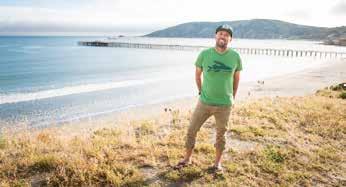

























“Whether it’s during harvest or a busy weekend in our tasting room, it’s comforting to know TekTegrity is only a phone call away, 24/7.”


Sue O’Sullivan, Compliance Tolosa Winery

























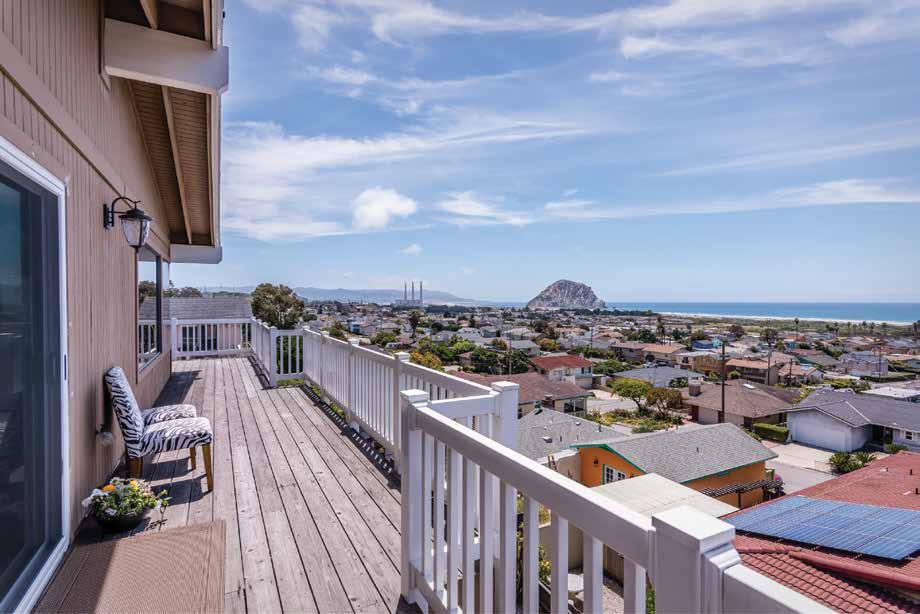




Here we are in Market Square in the beautiful medieval town of Bruges, Belgium—where waffles, “frites,” mussels, beer, chocolate, canals, and culture are in abundance.

—
Here we are in Stykkishólmur, Iceland 65°N. We have been enjoying this magical land soaking in geothermal waters every day, hiking over lava rock formations, and enjoying the abundant waterfalls.

— SCOTT, EVA, ANAIS, AND ANGELES
—

Honoring our 70 year history as San Luis Obispo Little Theatre while building our future as San Luis Obispo Repertory Theatre – a professional, nonprofit, regional theatre.
A new name for live theatre in downtown SLO slorep.org























The county coroner reported that Andrew Chaylon Holland died as an inmate at the SLO County Jail after being restrained to a chair for a period of 46 hours. Ruling that the death of the 36-year-old had been “natural,” resulting from an intrapulmonary embolism—a blood clot originating in a leg vein— his family was quick to point out that a leading cause of clot formation was unusually long periods of sitting. Sheriff Ian Parkinson said that jail staff followed appropriate protocol during Holland’s two days in restraint and that being strapped to the chair did not cause the clot to form.
San Luis Obispo City Council elected to give 93 management employees one-time $2,000 bonuses to make up for an inequity of contributions to their health care costs. The distribution totaled $186,000 and came a little more than a month after it was revealed that the city was facing a combination of sharply rising pension costs along with lower-than-forecasted tax revenues, which is expected to leave an annual budget shortfall of $5 million within the next four years. By 2021, the expected pension burden is thought to be $19.1 million annually, while the overall budget should come in around $84.3 million— meaning 23 cents of every dollar the city spends four years from now will be on pensions for retired employees.

After spending $70,000 with a Santa Ana-based law firm to investigate the “sexy firefighter video” aired at the SLO Chamber of Commerce annual dinner in January, San Luis Obispo’s City Council, following a closed-door meeting, opted to dock the pay of Fire Chief Garret Olson by $5,442, the equivalent of an eight-day suspension (Olson receives $176,852 per year not including benefits) and City Manager Katie Lichtig received a one-time fine of $2,659 (Lichtig receives $230,464 per year not including benefits), an amount she would have earned for three days of work.
Frustration boiled over among San Luis Obispo’s City Council when a “nondiscrimination in housing” effort forced their hand in providing a special election this summer at a cost ranging from $119,000 to $158,000. The petition instigated by lawyers Stew Jenkins and Dan Knight along with former City Councilman Dan Carpenter was originally promoted locally as an effort to overturn the city’s controversial housing inspection ordinance; however, when that ordinance was reversed by the city council earlier this year, the trio continued to push forward with what many suggest is an end-run attempt at overturning city programs that support housing for the poor and elderly.
An audit conducted by the State of California confirms what many faculty members have been claiming for years: Cal Poly has become top heavy with administrators. The audit, which analyzed the academic years of 2007-08 to 2015-16, arrived at three primary conclusions: the university hired management staff without justification for the new positions—administration grew by nearly 50% during the audit period (compared to 15% across the CSU system and a 7% increase in teaching staff); Cal Poly provided administrator raises without justification—in 2016 alone, 70 managers received increased pay without proper performance evaluations; and there had been no oversight of moving expenses allowing compensation for relocation of new hires to rise into the tens of thousands of dollars—for instance, Jeffrey Armstrong received $50,000 for his moving expenses when he became the university’s president in 2011.

A group of neighbors in North San Luis Obispo banded together to file a lawsuit against the SLO City Council over its approval of the controversial 33-unit apartment building at 71 Palomar Avenue. The plan calls for removing 55 trees from the 1.3-acre property, relocating the historic Sanford House, and the opening of Luneta Drive to through traffic. The developer, Loren Riehl, an El Segundobased lawyer, has argued that there is no “legal or factual basis” for an Environmental Impact Report. Longtime permanent residents in the neighborhood—an area that is increasingly occupied by students— have expressed frustration with the city that the property had not been converted to a park. Many residents on the north end of the city, who increasingly feel they are not being represented, have begun to openly question city elections that are held “at-large” and not by district. Currently, none of San Luis Obispo’s five council members reside in the 93405 zip code.

Two years after its permit was denied, owners of the Las Pilitas Quarry in Santa Margarita applied again with the county to move forward with the 41-acre project. The controversial plan was met with resistance from protesters concerned about the hundreds of gravel-carrying trucks that were expected to pass through downtown Santa Margarita, as well as the environmental consequences and noise that come from blasting at the site. At the time, the project was shot down by a 3-2 vote with former Supervisor Frank Mecham joining Adam Hill and Bruce Gibson (Supervisors Debbie Arnold and Lynn Compton voted “Yes”). At the time, Mecham’s replacement, John Peschong, stated that he would have voted to approve the quarry.

SLO High special education teacher Michael Stack penned a letter to the student newspaper in which he cited Bible verses claiming that people who commit homosexual acts “deserve to die.” Students, teachers, and parents immediately and sharply rebuked the letter while administrators attempted to calm their outrage, prompting a debate pitting First Amendment rights against the separation of church and state. Stack, who said in his letter that he “didn’t want to displease God” and claimed that the Bible is “without error” and that its predictions are “100 percent accurate,” had been a firstyear probationary teacher that administrators determined back in February would not be asked to return. Following the publication of his letter, Stack failed to return to campus and instead resigned by email, which he also copied to Fox News.
Adam Hill and Bruce Gibson, who make up the progressive bloc on the SLO County Board of Supervisors, claimed that it was the “toxic majority” made up of conservatives Debbie Arnold, Lynn Compton, and John Peschong, who forced out popular Chief Administrative Officer Dan Buckshi after his announcement that he was leaving to become the city manager in Walnut Creek. Buckshi was widely credited with leading the county unscathed through the recession while implementing reforms that led to an increase of its bond rating to AAA, the highest possible. Following the announcement, Supervisor Adam Hill circulated an opinion piece among local media that read in part, “Dan was subject to too many months of hostile, disrespectful treatment by Supervisors Lynn Compton and Debbie Arnold, which was abetted by Supervisor John Peschong.”
Just off Highway 101 North, near Paso Robles, sitting by itself atop the gentle slope of a lone hill is the Kim Kardashian of coast live oaks. Perhaps no other single tree locally has been more talked about, posted, shared, liked, and commented on than the one you see here. A little farther away still, around 100,000 light years or so, are the stars in the background.
It was a few years back, on a crystal clear night that Mark Gvazdinskas loaded up his camera, a Nikon D800, a wideangle 24-70mm lens, and a tripod into his car, and made a beeline for the spot he likens to a scene from a Dr. Seuss book. After settling into a rut on the side of the road, the young photographer stumbled across an uneven pasture when the famous tree came into view. Setting his camera to a twentysecond exposure—the longest he explains is possible before the stars start to move, which would render them blurry in the composition—he recalls his excitement after looking down at the tiny screen on the back of his camera, “I just lost it when I saw how well the shot turned out; it was just the perfect scene.”

Although commonly described as being far, far away, the Milky Way is actually home sweet home. You live in the Milky Way, a spiral shaped galaxy that is in a state of perpetual rotation. Ancient peoples almost universally described the night sky as a “river of milk,” a name that stuck and has since evolved. The wonder of our own interstellar backyard is mesmerizing, especially when juxtaposed against something familiar, such as the little oak tree, which is what Gvazdinkas has done with this photograph. But, to truly gain an appreciation for the sheer size and scale of our own galaxy—just one of the 100 billion known to exist—consider this: an astronaut traveling at 515,000 miles per hour (the space shuttle currently reaches a maximum speed of 17,500 miles per hour), to make it all the way around the Milky Way, would take 230 million years.
SLO LIFE
The other day, freshman San Luis Obispo City Council Member ANDY PEASE bicycled over to our office for a conversation that bounced around topic proper way to swing a pickaxe (use your legs) to speculation ab (the jury’s out) and everything in between. Here is some of wha

Let’s take it from the top, Andy. Where are you from originally? I grew up in the Bay Area. I was in the Santa Cruz mountains when I was really young, Ben Lomond. My parents were hippies. They split up when I was very young. I spent my school years with my mom and brother in California, the Palo Alto/Redwood City area. During the summers, I’d go to Oregon where we had a big family, stepmom, stepsiblings. My dad taught architecture at the University of Oregon in Eugene. He was into a New Urbanism approach in terms of wanting to design communities for walkability. I remember as a kid him showing me site plans with homes and talking about the role the front porch plays, and the importance of having the kitchen window placed so you could look out and be engaged with what was happening on the street. We were all riding our bikes back then; we didn’t get shuttled around by our parents like we do now. So, I think I had an awareness of the built environment just by being in it, and by talking with my dad.

Tell us about college. I did a gap year. I was really burnt out after high school. I did the California Conservation Corps for a year. I wasn’t sure that I wanted to go to college, but I felt renewed after that experience. I was ready for a new challenge. I went to M.I.T. It was really a reach school for me, but it was at a time when they were looking for diversity. I’m no genius, but I was smart and hardworking, but also female and low-income from California; plus I worked. It was a good experience. I loved going to school in Boston. I did gymnastics there, but it wasn’t that big of a deal; it was a Division III program. But, it was definitely an anchor for me. It helped me through some tough times. Out of college, I was recruited by a contractor and worked in Atlanta for a couple of years doing construction management. I love construction. I did construction jobs during the summers—carpentry, painting, pick and shovel work, you name it. It was a really good experience. I think that it gives us architects a better appreciation for who we are drawing for to get the thing built. I tell young architects all the time, kids who are considering going into architecture, to do some jobs in construction first, don’t just jump into architecture.
How did you end up here in San Luis? I have a cousin who was living in L.A. and was getting married and I was debating about making the trip and I thought, “Well, his cute friend Frank might be there.” I had met him a couple of times before. Anyway, I flew out for the wedding and that was it. Frank and I were long distance for a year. Then I moved out to L.A. We were in Santa Monica, and I worked for an architect there. We decided that we wanted to do a Peace Corp-type thing, so he found a job as the ophthalmologist for a Caribbean island called Dominica, which at first we confused with the Dominican Republic. We went
anything at all. It’s better to not know the answer and just move forward in the best way that you can.







Sixteen years ago, PHILLIP TORIELLO welcomed 28 students into the very first session of the Avila Beach Junior Lifeguard Program. Today, as the organization’s co-founder and lead instructor, the group has expanded to 200 participants—“kiddos,” as he calls them. And, this summer, like every summer, he can be found on the beach teaching and coaching, sharing the lessons that were largely missing from his own childhood. Here is his story…
 PHOTOGRAPHY BY VANESSA PLAKIAS
PHOTOGRAPHY BY VANESSA PLAKIAS
Okay, Phill, we like to start off by asking you where you are from. I was born in Texas. San Antonio, Texas. Lived there for a year before the mom skedaddled on dad and headed to Ventura, California where I grew up for 16 years. In the
summers when I was younger, I had a lot of friends who were involved in aquatics and such, who would go to do junior lifeguard programs, or surf camps, or on swim clubs, and swim teams. And I didn’t have that privileged opportunity, so I’d be the kid who was waiting in the neighborhood for all the friends to get home. And then, hopefully, get some time to hang out and play. As I got older, I was playing baseball and everyone was going to do football. I’m going to do football. And mom goes, “Football’s out.” Some of my friends said, “We’re going to do water polo.” I’m thinking, “I have no idea what that sport is. I’d never do that. I haven’t been on a swim club.” But, just before high school started I joined the Freshman Summer League Water Polo Program.
How’d it go? I’d come home beat. Ruined. Absolutely ruined. Completely exhausted. Eyes burning with chlorine; but, somehow loving it. Feeling like I found a groove, something I might be good at. So by the time I was 16 there was a divorce in the family. Mom hauls us up to Salinas. It was definitely not a beach community. And no water polo team; barely a swim team. I’m having a tough time finding my place up there, and eventually gravitate towards the swim team. And then I started getting into swim clubs. Start getting into the water polo club at Hartnell [Community College], and start finding a serious groove towards my senior year. Then I’m trying to figure out college; no one has gone to college in my family and I’m being raised by a single parent. I look around and decide to check out Cuesta College. I go talk to the swim coach and explain my situation and ask about a scholarship and he says, “We don’t do

that stuff. You can come down here. And you can be on my team. But otherwise it’s all on you.” And I’m like, “Well, that’s unfortunate news because I don’t know how to finance this.” And so, I make a complete left hand turn and join the military.

That is a different path, for sure. I join the military for the G.I. Bill. Take off. First place is Arkansas. And that was kind of a shock. And then, you get a “dream sheet” after your first year, which is like a wish list for where you want to be stationed. So, I put down Hawaii, Guam, the Philippines, anywhere but Arkansas, preferably California. Just get me to the coast. The last one I put on the list was England. And, so England it was. And I went to England for three-and-a-half years. During my time there, I was invited to the United States Air Force European Swim Team, which I thought was, “Let’s go around to the other U.S. military bases and compete against other teams.” What we were doing was traveling to other European countries and competing against their best teams. I didn’t realize that until we showed up at the Olympic Training Center in Warendorf, Germany. We’re this scrappy little crew of Americans going up against Olympians from Europe. Denmark’s there, Germany’s there, England’s there. It was a great experience to be in the realm of that level of athleticism, but I could see that I had taken it as far as it could go. So, when I left the military I thought, “Where am I going to go next? What am I going to do?” And so, I saved up enough money to buy a one-way ticket to Hawaii. I’d never been there before.
Talk about that experience. I disappear to Hawaii. I’m trying to find my groove there. The ocean was fantastic. Surf was every day. But finding jobs as a transplant haole is like a three to four-month ride. So, I started working as a towel boy at the Olukai, and then got a job on base as a lifeguard at Hickam Air Force Base. And eventually got what I felt then to be the ideal job working at Duke’s in Waikiki. And so, I worked there for like four months, and as I was kind of going down that restaurant route and living in paradise, having this great time. I started to realize really quickly that my goal of going to college was starting to disappear down there in paradise. So I go to Kapi’olani Community College. I say, “Hey, what do I need to do to get in here?” And they tell me, “Well, you need six more months of residency in order to get residency tuition, otherwise you’re considered out-of-state.” So I called up Cuesta, and asked, “What is it going to take for me to get out there?” And they said, “You can register right now over the phone.”

Okay, so that’s how you made your way to San Luis. Yes, and I went back to the swim coach and he said, “Hey, you should join my team.” And I’m like, “Really?” In the back of my head I’m thinking, “You’re the same guy who I begged for help years ago.” He didn’t remember me. And so I signed up and became the captain of the Cuesta Swim Team for two years. And at the end of that second year, I informed him. I said, “Hey, by the way, I’m that guy from four-and-a-half years ago you never remembered. You kind of put me in a pinch to go to the military.” But I thanked him for it and told him it was a long path to get back here, but, I mean, I thanked him for that amazing experience. It was around this same time that a friend of mine kept saying, “You’ve got to come be a lifeguard in Avila.”
Seems like a natural fit for you. What was that like? I was working a bunch of jobs and needed to finance school, and it just clicked. Later, when I was at Cal Poly, we decided that we needed a junior guard program in Avila. This was about 16 years ago now, back in 2001. There were a few of us and I was the lead instructor, which is still my role today. Hands down, Junior Guards is the most amazing youth program in the world. There’s no other program that comes close. You’re bringing kids out to the beach for five weeks to introduce them to the components of being a lifeguard. Everything from running down the >>
beach, to taking paddle boards out into the sea, and learning different ocean dynamics, and learning the different variables in and around our coastlines. During that period of time, kids will go through the most incredible growth process socially, mentally, physically, psychologically. We started off that first year with 28 kiddos and now we’ve built it up to 200. And, out of that 200, every year I’ll have three or four kids who are losing their minds; they don’t want to go into the sea. They are the ones I love the most because of the challenge.
Expand on that, if you would. Because they haven’t been brought up around the ocean, it challenges me to come up with the right words, body language, and guidance to help introduce them to this amazing experience. I’ll look around at the group during the first day and say to myself, “Okay, which one is it going to be?” And you kind of see the ones who are a little bit timid by their body language and everything. And by the end of the five-week session these kids are animals, just going for it. They completely evolve and open up socially, athletically, and by the end of the day you can’t get them out of the ocean; they won’t leave. To me, that is the best satisfaction and gratification in the world because I get to see those results each and every day. Honestly, it’s probably one of the greatest feelings I’ve had because you’re dealing with young lives, educating young minds,
unlocking something that otherwise may have never been unlocked.
Is there a kid that stands out in your mind? Oh, wow, there are so many. Just a week ago or so I had a dad come out and tell me that his teenage son wasn’t going to be doing Junior Guards again this year. He’s a sizeable kiddo, probably 6’ or 6’1”, fourteen years old, and he’s oscillating, like so many teenagers start to do. He’s oscillating, but still interested, still harvestable. So, I pull him aside and sort of get in his face a little bit and ask him, “So, you’re joining Junior Guards this year, right?” He’s like, “No. No. I don’t know. I don’t know.” He’s kind of grumbling, kind of growling, and I tell him, “That doesn’t sound right to me, man. I’m going to ask you again. Are you doing Junior Guards this year?” He’s kind of looking down and saying, “I just don’t think I’m in shape.” So, I respond, “That’s not what I want to hear. It sounds to me like you really need this right now.” And so I went into this ten-minute, like Tony Robbins session with this kiddo. “Listen, I’m not going to force you. I’m not going to tell you that you should do it. I’m going to leave it up to you. I’m going to let you walk away right now. And you’re going to dream about this tonight. You don’t have to make a decision now, but tryouts are, in fact, tomorrow. So, I’m going to leave you with this choice.” By the end of that day, the dad runs up to me on the beach and he was kind of emotional and he says, “Hey, >>









Phill, I just have to thank you. I don’t know what you said to my son, but he’s going to tryouts tomorrow!” I mean, it’s moments like those that make me come back to Junior Guards every year.
And, what do you do when it’s not summertime? So, the rest of the year, right now and for the last six years, I’ve been operating an in-home preschool with my wife. We have ten to twelve preschoolers a day, two to five years old. It’s called Meemee’s Little Rascals. I go from sixteenyear-olds on the beach to two-year-olds the rest of the year. I’m kind of the teacher of the group. I guess you could call me the Director of Entertainment and Redirection. [laughter] My wife does more of the arts and crafts, and we mutually watch over the kids and do a structured learning program. I like pushing kids to their limits. They’re capable of so much more than they ever think, regardless of age. I mean, I’m doing lessons on the Mesozoic Era, Triassic, Jurassic, Cretaceous periods, and I’m taking them through carnivores and herbivores and identifying and kind of analyzing the planets, you know; the solar system; and teaching them Spanish. It’s intense, but, yeah, I have to say that it’s probably one of the more involved jobs I’ve ever had in my life.
How did you and your wife meet in the first place? I was going through a hard time and about to hightail it out of town. The transmission on my car just went out. I was between jobs. Out of money. It was raining and my

friend picks me up. We go to Starbucks and there’s this girl working there who’s handing out samples. She comes up to me and says, “Would you like to try a Chantico?” Which is a kind of hot chocolate. And I’m like, “Oh, I’ve never had that before.” And she says, “Oh, have you not?” I’ve got this thing with words, and when she said, “Have you not?” It struck me as different, interesting. So I’m thinking, “Oh, Hello! That sounds like the right potential.” It was totally weird. Totally different. Interesting. We walked outside back into the rain and get into the car and I tell my friend about her. He says to me, “You need to ask her out.” I’m like, “Dude, I am not asking anybody out. I’m in the last place in the world to be able to do anything like that.” My car just broke down; I don’t have a job. I’m like a country song. Dark clouds were hanging over me. But, he stayed on me. “No, man, you need to go back in there.” So, finally I said, “Alright.” I go in and get her number. I think it was two weeks later, the day I finally produced a car, that we go out on a date. We’re married now; Jamie’s eight generations deep here in San Luis Obispo, which I guess that makes Curren, our two-year-old son, nine generations here in town.
And what about your dad? It sounds like you never knew him. I snuck up on my biological dad when I was 32. It was around the same time I met my wife. I was at a point in my life where I needed to figure things out, I needed to get rid of the ghost that I had in my closet. I hadn’t had any contact with him through my life, >>
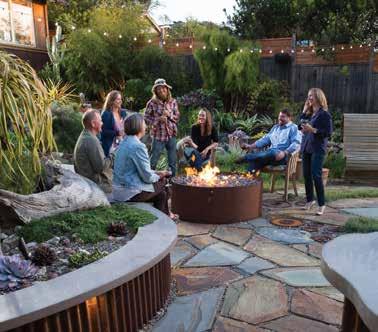





except for an occasional correspondence when I was younger. It was very surface. When I was in the military I tracked down his phone number and called him from the base one night. I said, “Hey, it’s your son.” And he said, “Oh, hey, can you call me back? I’m having dinner.” It was weird. I just remember thinking, “Dude, you have no idea who I am.” I was young, kind of angry, kind of lost, and needing some direction at that point. Looking back on it now, in retrospect, I do think it helped shape me into who I am now as a responsible older adult. But at the time, I’m trying to close the chapter. I needed to see this guy face-to-face. He hasn’t had the nerve to meet me, so I’m going to sneak up on him.
Whoa—that’s heavy. I tracked him down. I had a friend who was living in Virginia at the time, which was the state that he was living in. And I’m like, “Hey, can I fly out? Can I stay at your place? And can you help me out with something?” She said, “Yeah, come on out.” So, she picked me up from the airport. I stayed at her uncle’s house. The next day, I called around to some of the restaurants to try to pick out which one he’d be at. And I narrowed it down to one where he’d most likely be working. It was Thanksgiving Day. We drive off to this restaurant. It was about an hour away, and we pull into the parking lot. I walk in and said, “Hi, can I please see so-and-so.” I didn’t know if he’d be there or not. They’re like, “Yeah. Hold on.” The place was packed. And, so I went and stood in the corner while the lady went off to find him. Finally, this man walks up and says, “Can I help you?” And I said, “Yeah, do you know a guy named Phillip Toriello, by chance?” And he’s like, “Uh… yeah.” I’m like, “Well, I’m that guy. How are you doing?”

Wow. And it just turned into a very weird interaction from there. It was incredible. It was an incredible experience; one of which I’m really happy I did. We agreed to go out to dinner the next night at some beachside town. And it was just this really, really weird encounter. It felt like a business meeting more than anything else. And it was at that point I said to myself, “Alright. This is nothing. There’s nothing here.” It was mind-blowing, such a confusing time for me. I was hoping for more of an emotional connection. Maybe hoping to hear him apologize for bailing, maybe something like, “I apologize for not taking initiative more over these years, but I’m really glad that you did. I’d really like to see this develop.” None of that happened. So, I thought to myself, I’m just going to take advantage of the tab. Eat steak and drink wine and call it a day; call it a job well done. Good for Phill. And that was it.
Do you think that experience shaped you in some way? Yeah. One hundred percent. That’s how I look back at my life now. I can’t be angry about it, because everything that I’ve gone through has made me who I am today. I think that’s contributed to a lot of what my thing is with working with children. So, yeah, without a doubt, it really was the groundwork for what I strive for now; providing things that I wasn’t provided with, those things that I was missing like respect, and listening, and sincerity, and guidance, and direction, and integrity. If I didn’t have that experience would I still have the same passion for teaching? Would I be able to contribute to San Luis Obispo’s youth in the same way that I do now? Who knows? Nobody really knows the answers. But, in thinking about where I am today— it’s a good place. SLO LIFE







With their power-folk Americana sound, Central Coast duo Bear Market Riot is here to spread some joy: “We realize the diversity of thought within the area, but our common humanity binds us all together, and sometimes that gets so lost. We want to share our positivity and get people to come together,” says singer-songwriter Kirk Nordby.
 BY DAWN JANKE PHOTOGRAPHY BY STEPHEN DUMMIT
BY DAWN JANKE PHOTOGRAPHY BY STEPHEN DUMMIT
6/22 . Barrels in the Plaza . 4:00 p.m.
7/7 . SLO Concerts in the Plaza . 5:30 p.m.

7/12 . Solvang Concerts in the Park . 5:00 p.m.
7/25 . CA Mid-State Fair . 7:00 p.m.
Kirk Nordby and music partner Nick Motil came together in early spring of 2014 when they performed solo acoustic sets at one of Steve Key’s Songwriters at Play showcases. Explains Nordby, “After our sets, Nick just flat-out asked if
I’d be willing to hang out and play music with him. At the time, we both were in transitional places as new residents of the area with only a small handful of friends between us.”

The two began to develop their identity as Bear Market Riot at the Monday night Baywood/Los Osos Farmers’ Market. Motil brought a suitcase drum he made out of an antique leather hatbox that enhanced their acoustic sound, and the pair became regulars on the scene. “That was the beginning of it. We had our orange tip bucket out and would make forty bucks and some cucumbers. Better yet, we made friends with the locals, and their encouragement, as well as our own recognition that we were blending our sounds well together, kept us going,” says Nordby.
Nordby, who hails originally from Bainbridge Island, Washington, relocated to the Central Coast in 2011 after traveling through San Luis Obispo with Olympia-based band, Baker London. “I have a very supportive family, so I took the leap of faith. I became a line cook under Chef Chris Kobayashi at Artisan in Paso Robles and was trying to stretch my legs in the local music scene when I met Motil.” Motil grew up in the rural Midwest and toured as a singer-songwriter in his twenties before moving to Pismo Beach with his wife. “By now, we both have golden handcuffs locked to this area,” admits Nordby.
With so many music venues on the Central Coast, it has been easy for the duo to perform live almost every day, and they do so happily. In fact, Bear Market Riot has played on just about every stage in the county, including at the wineries and breweries, as well as at the California Mid-State Fair, Whale Rock Music and Arts Festival, SLO Brew, Vina Robles Amphitheatre, and Live Oak Music Festival. Nordby adds, “The coolest show we played last year was Concerts in the
Plaza, and we’re playing this year, too. It’s a really big deal—we’re so amped.”
Nordby and Motil are also amped to celebrate the vinyl release of their first full-length album, Power-Folk Americana, this June, which was produced and mastered with funding they secured through a successful Kickstarter campaign. Nordby shares, “The network Nick and I have developed in SLO County worked for us: our community held us up, and it was amazing.”
Nordby continues, “We have elected to grow here on the Central Coast, to continue to build our local fan base, and it’s paying off. We bring our own songs to the table and have fun with them when we perform, but we also play covers in different tempos, keys, or time signatures, and people just let loose.” Among their most popular covers are Simon and Garfunkel’s “Cecilia” as a waltz and a bluegrass version of R. Kelly’s “Ignition (Remix).”
Collaboratively writing new music is now at the forefront for Nordby and Motil, music reflective of a more adult place that captures the intricacies of everyday life. And Nordby recently added the baritone to the list of instruments he can play, so the power portion of Bear Market Riot’s power-folk sound has expanded. He explains, “The baritone is strung four steps below a regular acoustic guitar, and we have been pushing that tone through an amplifier to generate a bass tone, so on top of our step drum and guitars, we now have the bass.” As well, Motil added a foot tambourine to the mix, “So we have gain and grit: vocals, harmonica, bass, drums, tambourine, and guitars,” says Nordby. Or, as the band’s website describes it, Bear Market Riot is “two bearded men playing seven instruments.”
While the two at times trade off on lead vocals, Nordby and Motil perform many of their songs together in harmony. Their sound combines a variety of genres representing the duo’s distinct musical influences. Nordby credits David Bowie for inspiration, in addition to English rock bands T. Rex and Roxy Music; Motil lists The Killers, Everclear’s Art Alexakis, and singer-songwriter David Gray among his influences. So they draw from rock and pop music, yet the band emits a bluegrass, country vibe. As Nordby jokes, “We’re bears in sheep’s clothing.”
However they are described, it is clear that Bear Market Riot is a favorite among locals, recently voted SLO County’s “Best Band” for the 2017 New Times Readers’ Poll. “By the grace of SLO County residents, who are extremely friendly and supportive, it is working out for us,” observes Nordby.
Their vinyl is pressed, thank you notes are prepared, and the band is ready to celebrate with their community this summer. “In the genesis of small bands that make a lot of noise,” says Nordby, “we’re a riot. We break the fourth wall and talk to the crowd a lot, making corny jokes and putting off a hoedown vibe.” In effect, Bear Market Riot is positively infectious and their sound keeps the people on the dance floor satisfied.
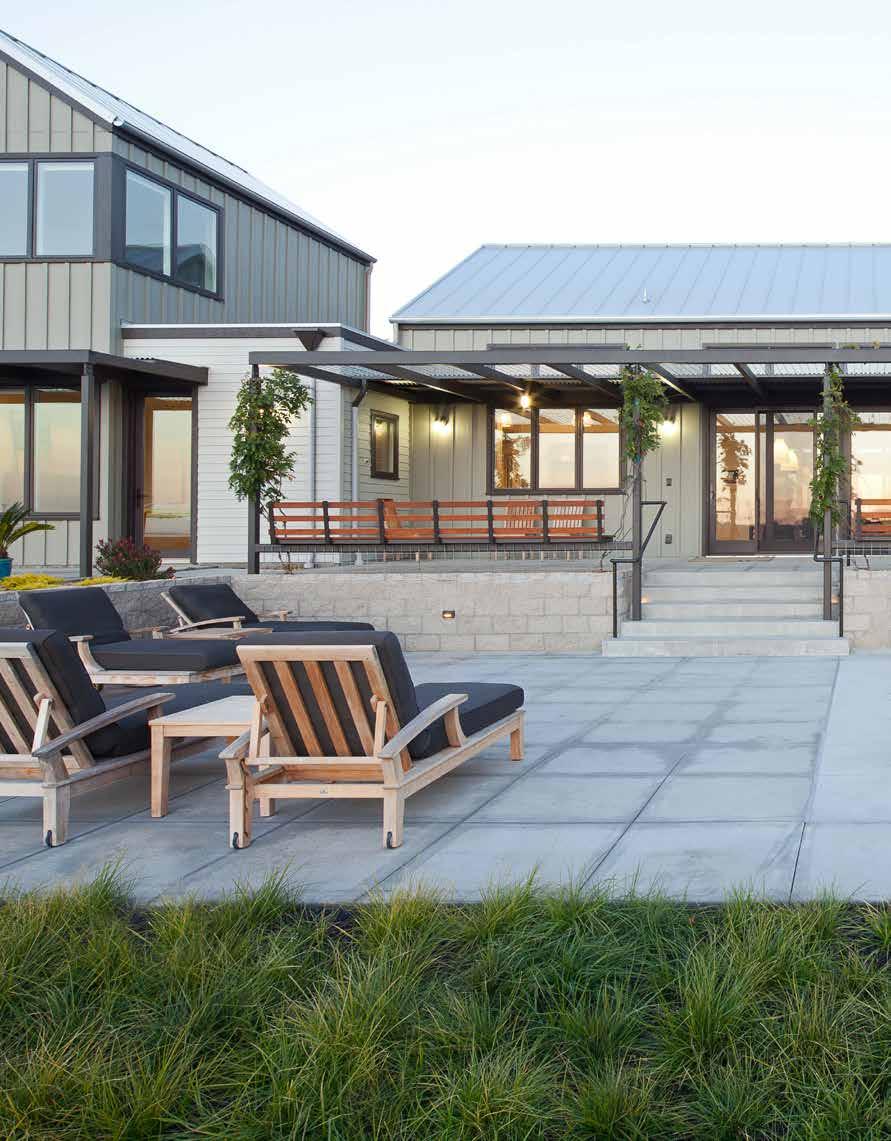
The secret to good editing is knowing what to cut and knowing what to keep. For JOHN P. LINDSAY and his wife, LESLIE WARD, elegantly honing raw materials down to their essence has become second nature. The couple had spent their long careers as editors at the Los Angeles Times, training their senses to capture rhetorical gems while reflexively discarding the “fluff,” those extra words that do not add to the story.
 BY ELLIOTT JOHNSON
BY ELLIOTT JOHNSON
Fittingly, it was another newspaper that brought the retired journalists to the Central Coast in the first place. An ad in the Wall Street Journal beckoned readers to “Live with the Land” at the Las Ventanas Ranch neighborhood, an “ag cluster” abutting Talley Farms in Arroyo Grande. The concept was intriguing: a fraction of the farmland had been subdivided into home parcels creating a quasi-neighborhood. It took the best elements of country and suburban living, combined the two and offered it up into neat little building parcels within an ocean of protected open space. The editors were sold.

Immediately, Lindsay and Ward dove into the project, treating it as if they had just received a hot tip on a story. Reverting back to investigative journalism, the couple followed every lead. It was a house they found in Louisiana that finally connected all the dots and broke it wide open. With the vision established, the couple set out to find an architect, and a builder, simultaneously. “A lot of people hire an architect and say, ‘Here’s what our dream is,’ and the architect draws their dream house and then they go out and get three bids from builders, and they are all much higher than they thought, and they are horrified.”

After a series of interviews, relatively quickly the couple had their team in place. David Gast of San Francisco, who had a bevy of modern farmhouses in his portfolio, was selected as the architect. And, Semmes & Co. Builders of Atascadero was tapped as the general contractor. The first of many conference calls began with the challenge to hone the project down to its essence—no fluff—and remain within budget. Along the way, Jessica Steely, General Manger of Semmes & Co. Builders, maintained a spreadsheet with different budget scenarios ranging from low to middle to high in an effort to rein in the spending. “They went for ‘high-high’,” she

laughs. “Their creativity and their connection to the art world made this a fascinating collaboration. But, the budget was definitely a challenge—I don’t think they realized how sophisticated their tastes were.”
While the finishing touches—high-end marble countertops, hand-made tile, designer wood floors—get most of the attention, it is the various systems that the environmentally-minded couple chose that quietly do the heavy lifting in the background. A solar water system warms the pool, a photovoltaic array provides electricity, and a hybrid electric water heater supplies the hot water. The home’s passive solar design allows it to go without air conditioning as it takes advantage of sunlight throughout the year while accounting for the prevailing breeze blowing through the surrounding hills.

The dwelling, essentially a series of structures with steep-pitched roofs connected by flat-roofed hallways, is intended to look like a cluster of buildings huddled closely together. Everything is on one level, except for the upstairs exercise room, which may one day serve as the quarters for a live-in caretaker. Anchoring the farmhouse is the centralized great room where four sliding glass doors open, two on each side, to courtyards creating an outside-in feel to the already open, airy space capped by a vaulted ceiling hemmed with clerestory windows. The home flows intuitively and effortlessly from one room to the next, every detail carefully considered and seamlessly integrated, as family and friends who visit become enchanted, absorbed by the hillside farmhouse—in the same way readers of a well-edited story do. SLO LIFE




In this ongoing feature, SLO LIFE Magazine is proud to partner with the American Institute of Architects California Central Coast to unveil its current project winners and highlight our local design and engineering talent. Each month, the organization reviews submissions and selects the top Central Coast projects. Below are two recent installments to this series.
A husband and wife team based in San Luis Obispo, who make up the company flux DESIGN, was selected to design and construct a playhouse based on the following prompt from their client:
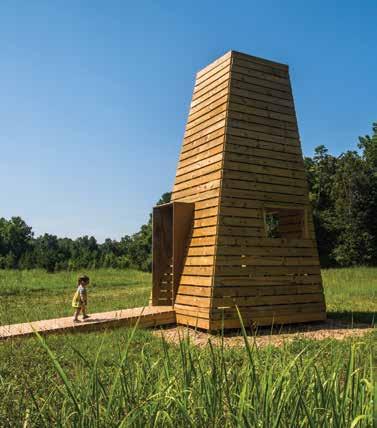

“Treehouses, forts and playhouses evoke memories of escaping outdoors to explore, dream and play, of hours of imagination and creating worlds of our own invention in the fresh air. Small play structures of all kinds, called Wee Houses for this exhibition, have always been important places we play. In 2016, Daniel Stowe Botanical Garden presents ‘Wee Houses: Places We Play,’ an interactive art exhibition to celebrate play structures with a design and installation competition.”
The goals set out by the client included engaging diverse audiences, inspiring creativity in outdoor play, creatively using natural materials, and responding to the varied landscape conditions of the botanical gardens. flux DESIGN’s proposal was based on the narrative of the book “I am a Bunny” by Ole Risom and Richard Scarry. This story details a year in the life of a bunny who lives in a hollow tree and, from the shelter and safety of his tree, explores and experiences the flora and fauna of the changing seasons. Constructed of wood with careful detailing, the hollow tree is a geometricized abstraction. It creates a perch from which to experience the changing context while framing it in distinct ways. The doorway is intentionally diminished to reflect the scale of its miniature users, and the apertures in the façade are positioned at different heights and orientations to frame elements of the surroundings, views that vary with one’s vantage point. The overhead aperture draws the gaze upward, framing a changing image of the sky and creating a dynamic play of light and shadow.



The American Institute of Architects has been the leading professional membership association for licensed architects, emerging professionals, and allied partners since 1957. The local California Central Coast division works in collaboration with SLO LIFE Magazine to showcase its monthly award-winning projects demonstrating notable concepts that have been constructed after being designed by local architects.
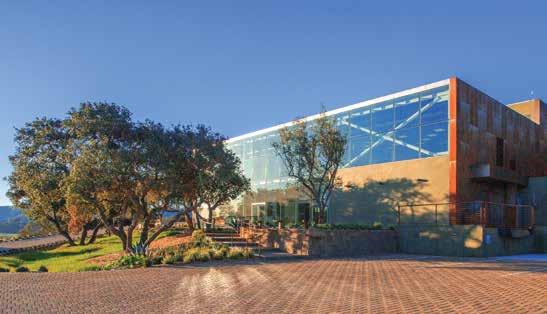
Hilliard Bruce Winery
Architect Val Milosevic
Green Consultant In Balance Green Consulting
Mechanical Knecht’s Plumbing and Heating Electrical JMPE
Landscape Arcadia Studio
Interiors Christine Bruce
Lighting ILLUM
Contractor Rarig Construction
Commissioning/HERS Palt and Associates
Photographer Jeremy Ball, Bottle Branding
Hilliard Bruce Winery is an 11,750-square-foot production facility and event space that unites aesthetics and function in dramatic fashion. Set in the hills of Lompoc, California, the modern glass and steel structure provides an energy- and water-efficient space for grape processing, bottling, and storage, as well as celebrations. The cyclical and intermittent nature of the building’s occupancy made multi-functionality important from an investment perspective and presented opportunities for resource efficiency and design optimization.
The two-story winery is built into a hill, facilitating grape delivery on a second floor covered crush pad and then a gravity-fed production process. Energy is also saved by locating the barrel storage in subterranean first floor rooms. Blending and processing share space with the project’s open kitchen and event area, which is fronted by a 28-foot north-facing window wall. The views from within and without are extraordinary and practical, as natural daylight is allowed to penetrate the production area, balancing light from suntubes, without unwanted solar heat gain.
This is a LEED Silver Certified project that has incorporated many additional environmentally sensitive design elements, such as balanced daylight throughout and reusing the processed water for adjacent field irrigation. Since water is such a sensitive resource, this project also maintains that 99% of stormwater is infiltrated and treated in on-site bioswales, and 52% of the site remains vegetated open space with droughttolerant plantings. Beyond the winery’s approach to water conservation, this project was constructed by regionally sourcing 32% of the materials. Also, a ten-kilowatt photovoltaic system provides 28% of total energy usage.

The Community Counseling Center has expanded its therapy space with the landmark purchase of 676 Pismo Street (the historic Piggot House). The property will be converted from residential to a professional office and is a forty percent increase in space for the agency’s low income clients in San Luis Obispo. Mary Moloney, realtor with San Luis Obispo Realty was helpful in the success of this purchase. Sin ce 1968, the Community Counseling Center has been the leading affordable mental health therapy provider for low income and under-insured residents of San Luis Obispo County.

Pictured: Irene Iwan, board president; James Statler, executive director; Al Amaral, board member; Tina Bailey, board member; Barbara George, emeritus board member

Total Homes Sold Average Asking Price Average Selling Price Sales Price as a % of Asking Price Average # of Days on the Market
2016 24 $658,608 $648,767 98.51% 42
Total Homes Sold Average Asking Price Average Selling Price Sales Price as a % of Asking Price Average # of Days on the Market
2016 15 $704,900 $701,267 99.48% 41
Total Homes Sold Average Asking Price Average Selling Price Sales Price as a % of Asking Price Average # of Days on the Market
2016 15 $762,860 $758,149 99.38% 14
2017 24 $661,512 $653,335 98.76% 24
+/0.00% 0.44% 0.70% 0.25% -42.86%
2017 7 $719,684 $712,843 99.05% 31
+/-53.33% 2.10% 1.65% -0.43% -24.39%
2017 19 $751,316 $739,969 99.49% 42
+/26.67% -1.51% -2.40% 0.11% 200.00%
Total Homes Sold Average Asking Price Average Selling Price Sales Price as a % of Asking Price Average # of Days on the Market
2016 8 $1,103,875 $1,060,500 96.07% 65
Total Homes Sold Average Asking Price Average Selling Price Sales Price as a % of Asking Price Average # of Days on the Market
2016 23 $710,904 $697,035 98.05% 30
Total Homes Sold Average Asking Price Average Selling Price Sales Price as a % of Asking Price Average # of Days on the Market
2016 14 $758,193 $746,893 98.51% 45
2017 5 $956,333 $937,890 98.07% 59
+/-37.50% -13.37% -11.56% 2.00% -9.23%
2017 13 $615,284 $611,080 99.32% 67
+/-43.48% -13.45% -12.33% 1.27% 123.33%
2017 20 $758,780 $747,922 98.57% 31
+/42.86% 0.08% 0.14% 0.06% -31.11%
Total Homes Sold Average Asking Price Average Selling Price Sales Price as a % of Asking Price Average # of Days on the Market
2016 16 $719,159 $709,142 98.61% 94
2017 18 $716,156 $708,306 98.90% 38
+/12.50% -0.42% -0.12% 0.29% -59.57%
SOURCE: San Luis Obispo Association of REALTORS®







BY
THE NUMBERS
Senior Living Within Reach.
Without Limitations.
With a variety of accommodations, here you will find choice, freedom and opportunity. We invite you to attend our June events and experience senior living within reach. Without limitations.

Open House Tour of Models Thursday, June 15 • 3 p.m.
Wine & cheese will be served.
Downsize Your Home, Upsize Your Lifestyle Thursday, June 29 • 3 p.m.
Presented by Joann Peters Light appetizers and cocktails will be served.
CA License # 405800545 Simply Abundant Living
Arroyo Grande
Atascadero
Avila Beach Cambria/San Simeon Cayucos Creston Grover Beach Los Osos Morro Bay Nipomo Oceano Pismo Beach
Paso (Inside City Limits)
Paso (North 46 - East 101)
Paso (North 46 - West 101)
Paso (South 46 - East 101)
San Luis Obispo
SOLD
2017 106 148 7 54 19 7 74 52 53 83 20 39 177 17 41 18 128 10 46 1,116
AVERAGE
DAYS ON MARKET
2017 68 69 118 86 127 119 46 30 60 55 64 47 50 51 122 80 41 46 72 61
MEDIAN SELLING PRICE
2017 $797,376 $551,406 $1,039,143 $661,369 $1,135,947 $730,857 $525,769 $600,944 $679,274 $609,428 $440,445 $1,104,985 $470,395 $471,609 $487,043 $828,581 $780,399 $390,700 $705,568 $628,815
SOURCE: San Luis Obispo Association of REALTORS ® *Comparing 01/01/16 - 05/25/16 to 01/01/17 -
REGION 05/25/17







Most people know they should do three things: save early and consistently for retirement, diversify their investments, and have an emergency stash of cash. Let’s go beyond the basics of financial planning 101. Here are five simple things that can make or break your financial success and lifestyle—at any age.
1. Get a living trust—and update it.
Living trusts can be relatively inexpensive, efficient, and a flexible way to control and protect your assets. If your assets exceed $150,000 and are not in an IRA, retirement, or pension plan, you need a trust. Some people try to get around it by listing some accounts as payable or transfer on death, or they title assets jointly with an heir. These methods can be effective in many situations, but you have to be mindful of the tax ramifications which can be more expensive than the cost of a trust. If you own real estate in multiple states, you should have a trust to avoid multiple probates in each state. In California, statutory fees of the probate process can easily run into the five figures vs. the cost of a trust which runs about $2,500 for a couple. A trust can also give you the flexibility to build in contingencies and dictate how assets are divided. For example, what happens if little Billy never paid back the loan mom and dad gave him 15 years ago—does he still get the full amount of the inheritance? You can also protect your bequests from being contested by family members and others, not to mention the distribution processing time is significantly shorter than probate. The list goes on and on—this is a no brainer. Once you have a trust drafted, make sure to update it when major things change— birth of a child or grandchild, divorce or re-marriage, or acquisition of a new asset. I can’t tell you how many times I see an ex-spouse listed as a successor trustee on separate property assets. Also, make sure to add your Trust as “additional insured” on your homeowner’s policy.
If you know what this is, then I’m impressed. Umbrella insurance is excess liability coverage in the event you’re sued for a negligent act. Your homeowner’s or renter’s policy usually covers an amount up to $300,000 or $500,000. If your net worth exceeds this amount, you need umbrella coverage. Umbrella is typically sold
in increments of $1MM, and can be relatively inexpensive (couple $100 a year per $1MM). Because negligence is common and easy to demonstrate, it only makes sense to get this, especially if you answer yes to any of these: Do you have a pool or hot tub? Do you have teen drivers? Do you have ATV’s or ORV’s? Here’s where you get the bang for your buck—if you are sued, the insurance company will typically provide and cover the cost for an attorney and your defense (because they want to minimize the claim). You can get umbrella insurance online or call your current home or auto carriers. Going through your existing carrier can sometimes be expensive, so you may need to shop around and contact a surplus lines broker. There are several good ones in SLO County.
Do you have cash sitting in your 401(k) account or your IRA that you rolled over from a former employer? Go fix that right now! If you’re 10 years or more away from needing the money, at least consider putting it in a Target Date fund so the money is working for you while you’re not thinking about it. Idle cash is an opportunity wasted, and you are losing money to inflation over time, even though the balance stays relatively constant. There will always be political changes, pending wars, and economic uncertainties, but time has a way of neutralizing the side effects— just don’t let fear keep you on the sidelines.
4. Get life insurance while you’re young and healthy. Life insurance is a greatly underestimated and inexpensive tool. Sometimes I run into people who think that the $50,000 life insurance policy they got through their employer is sufficient. Is that enough to pay your mortgage and feed your family? Some wait to get life insurance until after they’ve had a major medical issue or after they’ve smoked for 10 years. You can sometimes get it, but it’s expensive. There are several ways to figure out how much life
insurance you need and how long should you have it. But in general, you need enough so that your survivors can pay the bills for a few years if needed and/or pay off the mortgage, pay for college, and any other expenses like estate taxes. The term of the insurance should last as long as the need (usually until kids are out of college or until retirement age if your assets are built up enough). Even if you’re a smoker, some carriers will qualify you for non-smoker rates after abstaining for 1 to 3 years. You can always reduce the face amount of your policy (and the premium) later down the road if you don’t need as much—but you can’t add more coverage without underwriting. Even if you are not a breadwinner in the home, you need life insurance. What is the cost to replace what you do—care for the kids, maintain the home? Imagine what that would be like for your spouse if he had to work full time, but couldn’t afford to hire daycare or a nanny, hire a gardener, or pay to have repairs done on the house?

For most people, their number one asset is their income. Yet this is one of the most overlooked insurance coverages. Thanks to great medical care, many people now survive what would have been terminal injuries or disease. The financial “downside” of this is a period of time without income and simultaneously higher expenses. If you work for a large employer, they typically offer group disability at very cheap rates—get it! You can usually convert it to an individual policy if you leave with no additional underwriting! If you are a business owner or are in private practice and are responsible for your own paycheck, you definitely need disability insurance. There are many excellent carriers available depending on your industry, and many are often surprised at how affordable it can be.
A little planning goes a long way. Timing is everything. Next to investing and insurance, mapping out the timing of your large expenses and priorities can help save you a lot of money in terms of taxes, opportunity costs, interest rates, and when you can retire! Little things like misallocated or inefficient investment accounts can add years to the time you are required to work. Aside from investment and insurance advice, the bulk of the dollar value we deliver to clients is in terms of mistakes we help clients avoid and help in prioritizing how they fund their many expenses and goals.
There is a famous line in Nashville, often shared with daydreaming country western musicians that goes something like this: It takes 20 years to create an overnight success. For two non-profit arts organizations in San Luis Obispo, dreaming big suddenly looks like a perfectly reasonable thing to do.
BY TOM FRANCISKOVICHThe San Luis Obispo Museum of Art (SLOMA) and the San Luis Obispo Repertory Theatre (SLO REP), which is the recently renamed San Luis Obispo Little Theatre, are poised to dramatically reshape downtown within the

next three or four years, if—it's still an “if” and not a “when”—their new buildings are able to become a reality. Local policymakers light up with excitement and talk faster—much like a record company executive would in describing their next big hit maker—and they are beginning to grasp the coming of a new “cultural corridor” along Monterey Street in the area the organizations’ new multi-million
dollar facilities will soon occupy—that is, if the stars align. The corridor would also be made up of longtime neighborhood anchors, which include the Children’s Museum, the History Center, and the Mission. But, a few million hurdles still remain.
In some ways, the path forward for SLOMA is more clear, the finish line more visible. To be sure, it has taken a lot of gigs in smoky, mostly empty saloons to get to this point. Their story begins 17 years ago when the idea of building a world-class museum was first presented to the city planning commission. Over the years things finally started to pick up, a momentum was felt, donors were jumping on board, the city council gave the project its blessing; then 2008 arrived ushering in the Great Recession and it all came to a screeching halt. “We parked it; we parked the campaign,” is how Karen Kile, SLOMA’s executive director remembers those times. “But, people continued to give; they’ve been donating since the first glimpse of the [new building] design.” The donations served as seed money to carry the organization through the economic malaise and allowed it to live another day. Then, somewhere around 2013, SLOMA decided it was time to tromp on the gas once again—full speed ahead.
Last October, a full-time capital campaign fundraiser was put on the payroll. As a result, this year alone, SLOMA has raised $2 million from individual donors. “We have a very ambitious

goal,” Kile admits. “Go ahead and put it in print. We want to break ground in 2019.” The new museum at 26,000 square feet is estimated to take 14 months to build. Kile elaborates, “Just to put things in perspective for how long these projects take, the Copelands [developers of the current China Town Project] introduced their plans at the same city council meeting we did back in 2000 or 2001.” The city, to be sure, has been a longtime supporter of SLOMA as the current museum sits on city-owned land. While SLOMA owns the structure itself, and is fully responsible for its upkeep, the land on which it sits is leased for just one dollar per year.
The total budget for SLOMA’s capital fundraising campaign is $15 million with $12 million going toward constructing the museum and $3 million to be held as working capital for future operational expenses. Currently, the amount raised is $3.5 million. Fundraising efforts will intensify as 2019 approaches and Kile insists that building will not commence until the $15 million is “in-hand, or darn close.” But, the challenges facing SLOMA are just as much logistical in nature as they are budgetary, however, as the new museum will sit exactly where the current facility is now. In other words, the existing museum will be razed and the operation will have to temporarily relocate. Kile shares that she hopes a downtown space will open up for a short-term rental during the period of construction, so it can continue to host visitors during that time. There are a lot of moving parts to the plan and it will take some heavy donations, many, many grants, tons of individual giving, and a lot of logistical support locally, to make it happen. If Kile and her colleagues at SLOMA can pull it off, a world-class facility will sit a stone's throw away from, well, another world-class facility.
When SLO REP announced last month that it had changed its name, Kevin Harris, the organization’s managing artistic director, was quick to point out that only one word of its 70-year-old moniker was altered: San Luis Obispo Little Theatre became San Luis Obispo Repertory Theatre. The absence of the word “little” suggested that something big was happening. And, it is fitting since the organization has been on a five-year journey evolving from an all-volunteer theatre to one that is semi-professional. The change started to take hold in 2012, when after having trouble casting the roles of Pablo Picasso and Albert Einstein for the play "Picasso at the Lapin Agile," the theatre ponied up $300 plus housing for the actors. The show was a hit and it became clear that investing in acting talent was yielding a better product. It did not take long for audiences to notice the difference, ticket sales increased by 50% and the organization’s budget doubled to $750,000 putting it in the top 3% nationwide. Clearly, the investment paid off, and starting with the upcoming 2017-18 season, which begins in August, everyone, including all cast members and crew, will be paid.
It was around the same time that Harris was signing checks for Picasso and Einstein that the idea was floated for a new facility. The space the theatre operates within now is a city-owned building, the former library, which, like SLOMA, it leases for one dollar per year (it’s different in that it does not own the structure itself, it rents the entire property). As city planners envisioned an expansion of Mission Plaza, they began exploring different ways to maximize the space that already exists. A common complaint downtown is the lack of available parking. To this end, a parking garage has been proposed at the corner of Palm and Nipomo Streets. The idea is to have the garage and SLO REP’s new theatre complex share the same parcel. At this time, the parking garage is in the midst of its environmental impact report, which is one of the final hurdles prior to obtaining building permits. According to city officials, the very earliest the garage could be approved is this fall.
The question of the parking garage is significant. SLO REP and the city are tied closely together on the project—again, it will be renting the land to the organization for a dollar per year—because there are some economies of scale that can be achieved by partially building simultaneously. For example, the all-concrete multi-story parking structure would be an ideal time to pour the foundation for the theatre. However, it does also create a logjam of sorts in that the architectural design of the theatre cannot be finalized until the parking garage project is fully approved, therefore, the ultimate cost—although expected to be in the $6 to $7 million range—cannot be fully known. Local donors appear ready to support the project, but SLO REP will not be formally accepting commitments until the plan is complete. Plus, there is always a chance, although it appears remote at this time, that the parking garage does not receive an approval. Its denial would, of course, leave the SLO REP theatre plans in limbo. The fates of the parking structure and the theatre are very much tied together.
When seven thespian-minded San Luis Obispans passed the hat around in 1947 to fund the opening of a community theatre in a tiny rented space on Monterey Street, it would have been difficult to imagine a future that included 94% capacity for six shows a week, 42 out of 52 weeks per year. The idea for a new, larger theatre is not a “build it and they will come” roll-of-the-dice proposition, it's more like “build it because they are already here.” And, Harris, who speaks passionately about the overall effect of the Mission Plaza expansion, states,“Having this cultural corridor, or arts district, or whatever you want to call it, will be a tremendous boon to the city in so many different ways. It will allow us to make a concrete, tangible statement about the importance of arts and culture by creating a district right downtown that is dedicated to that.” While he admits that “the very best case scenario for groundbreaking would be 2019,” he does share Kile’s optimism that the community will support it and that donors are ready to step forward. And, like Kile, he is remaining focused on the vision, the ultimate outcome, which is the same thing some no-name kid is doing now as she strums the first chord on her guitar at her first gig in some no-name honky-tonk in the backwoods of Tennessee.








Driven by her love of politics and with a keen sense of adventure, this Mission College Prep High School graduating senior is rising to new heights.
What sort of extracurricular activities are you involved in? I’m the president of the Interact club at Mission Prep, a community service club sponsored by Rotary. I try to stay politically active, both locally and nationally. I interned for a local congressional campaign in the fall and volunteered at a polling station on Election Day.
What recognition have you received? When I attended the Rotary Youth Leadership Awards, the students in my group nominated me for a leadership scholarship. I was also a delegate at Girls State. The girls in my “city” nominated me for an Outstanding Delegate Award. I’ve also received a French Language Award at my school. Most recently, I was awarded one of the SLO County Weyrich Leadership scholarships.
What is important to you outside of high school? My biggest commitment outside of school is my involvement in the Junior State of America (JSA). JSA is a completely student-run organization. We spend weekend conferences debating and discussing anything from politics to pop culture to philosophy. I am part of the state leadership team, as well as president of my school’s club. I help plan the conventions, design t-shirts, and organize model congress. It sounds debate-heavy and intimidating at first, but I swear it’s fun! I’ve put in so many hours over the last few years that the conventions are basically my home away from home.
What is your favorite memory of all time? There’s one memory that never fails to make me (or my family) laugh. I was a foreign exchange student in France during seventh grade, and three weeks in, I managed to accidentally break off the handle to the bathroom door in my new home, locking myself inside. To make matters worse, the only other person at home was a five-year-old I was supposed to be babysitting. Yes, me, who still couldn’t speak French. And did I mention the three bees that flew into the bathroom? After attempting to communicate “door no open” in broken French, teaching a toddler how to dial the phone, and six hours later (not kidding), I was freed. I’ve never been comfortable in tight spaces since.
What has influenced you the most? Living abroad really shaped me into the person I am today. I spent six months in France when I was 13, and returned for another four months when I was 16. Letting go of everything—my friends, family, home, and language—made me realize what an absolute gift being uncomfortable is. You really find out who you are when all of the superficial things that define you are stripped away.
What are your career interests? I’ve always been interested in medicine and health, so I see myself drifting toward the possibility of a medical career. However, politics and international relations has kind of come to define my life outside of science classes. Ideally, I imagine myself traveling from country to country, fighting disease as an epidemiologist for the World Health Organization.
What is something few people know about you? I weirdly really like heights. I’ve been skydiving, cliff jumping, and rock climbing. I would love to get a pilot’s license someday!
What are your plans for college? I am officially committed to UCLA. Go Bruins!
Know a student On the Rise? Introduce us at slolifemagazine.com/share
SLO LIFE




Having French heritage, I grew up equating the smell of lavender to the finer things in life. From a fancy cocktail to luxurious linens, from silky bath water to an aromatic blend, lavender has been strongly connected to relaxation and luxury. If you’re like me, sitting in the warm sunshine, enjoying a fresh glass of lavender lemonade while looking out over purple fields conjures up images of France. But I’m happy to say this tranquility beckons from Atascadero.

 BY PADEN HUGHES
BY PADEN HUGHES
Visit
Harmony Lavender’s peak season for touring is in late June through August, as the fields are painted in bright purple flowers. If traveling from San Luis Obispo, allow 25 minutes in drive time and estimate an hour and a half for the tour. The tour fee is $10 per person. Certainly come ready to peruse the unique gift shop.


Lavender is part of the mint family—Lamiaceae of order Lamiales—a worldwide family that includes herbs, small shrubs, and a few medium to very large trees. Lavender is native to the Western Mediterranean region where bees gather nectar from fields of lavender, producing a monofloral honey that is sold at a premium.
For years, I’ve heard of the purple fields in North County that lace the air with the lovely aroma of Grosso Lavender. Over the freeway and through the back roads of Atascadero there is a beautiful, quaint lavender farm called Harmony Lavender. Thrilled to hear the local farm schedules tours and provides education about the process of farming and distilling lavender oil for use in food and home products, I couldn’t wait to explore.
Atascadero is full of surprises, and finding our way through a residential neighborhood to a private driveway with a sign for Harmony Lavender, was unexpected. Turning down the path, we were welcomed by rows of beautiful bushes blooming with long purple blossoms. We were greeted by Claudia Estrada, the passionate grower and cheerful tour guide.
We started off admiring the lavender fields. The farm boasts 2,000 plants. What began as a hobby with just two plants, Estrada started crafting soaps and gifts for her friends. I love hearing stories of people’s passions turning into business ventures, and the blossoming of Estrada’s lavender farm is just that.
“I like to do everything natural. I’d make soaps and things as gifts for friends. At the time we used our land for raising our [American] Paint Horses, but once my daughter moved away to go to college, I wasn’t sure what to do with the land. A friend of mine suggested, ‘Why don’t you do what you love and grow lavender?’” shared Estrada.

The business launched in 2009 with the purchase of 500 Grosso Lavender plants. The Grosso varietal is one of the largest lavender plants grown, and the smell is more strong than sweet. It grows heartily in Central Coast microclimates.
Our tour began with a view of the plants and discussion around what it takes to farm and grow lavender. We learned the full process, the expected yield, and walked the beautiful barn used to dry and sift the buds. In her biggest year, Estrada recalls storing 600 pounds of lavender buds.
She then took us into her workshop where she distills the lavender and it felt like being in a chemistry class again to watch her in action. From there, we viewed her gift shop with all the products she’s created over the years from soaps, to face balm, to the extract she sells to a local gelato maker.
We ended the tour by sitting under an awning next to a garden, while Estrada served us homemade lavender Arnold Palmers and lavender cookies. It was a beautiful finale to such an educational tour.
SLO LIFE PADEN HUGHES is co-owner of Gymnazo and enjoys exploring the Central Coast.Summer may be one of the busiest times of the year with vacations and holiday weekends, but that doesn’t mean there isn’t a little room for relaxation. What better way to take advantage of the warmer weather than by escaping the indoors? There are many health advantages to spending more time outside. In fact, simply having access to a green space can help you to de-stress considerably.
It may be wiser to invest in experiences over material objects since they tend to make us happier. Cornell University psychology professor Thomas Gilovich found that when we buy new things, we are only excited about them for a short amount of time because we adapt to their novelty so quickly. Alternatively, he argues that experiences represent our true identities better than our personal items do.

So the next time you are tempted to buy that new Apple Watch, consider a kayak excursion, instead. Or if you’re feeling adventurous, perhaps try an exhilarating bungee jump.
Gardening can be a form of meditation that allows you to spend time in nature while immersing yourself in a calming activity. One study from the Netherlands found that gardening can decrease cortisol levels and boost feelings of well-being among people who had just completed a stressful task. “We live in a society where we’re just maxing ourselves out all the time in terms of paying attention,” says Andrea Faber Taylor, Ph.D., a horticulture instructor and researcher at the University of Illinois. “Humans have a finite capacity for the kind of directed attention required by cell phones, and email, and the like,” Taylor says, “and when that capacity gets used up we tend to become irritable, error-prone, distractible, and stressed out.” The study went on to show that even 30 minutes of leisurely reading didn’t provide the same stress-relieving benefits of what is known as the effortless attention of gardening.
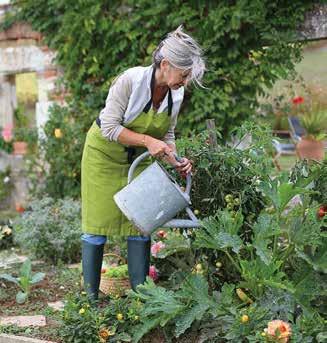


Yoga can be an effective stress reliever, and you can make your practice even more relaxing during the summer by moving outside. Bring your mat to a park on a quiet morning and practice stress-busting yoga moves, such as child’s pose, bridge pose, or extended triangle pose; or find a local “Yoga in the Park” class.
Taking a 30-minute stroll through nature can shift your mind into a state of zen. Research from scientists at Heriot-Watt University in the U.K. found that walking through green spaces can help put the brain into a state of meditation. Taking a walk can also boost your mood by lowering stress and depression, as well as by improving well-being. With so many great trails on the Central Coast, there’s no excuse for not getting out there.

Biking is good for the mind and the body, especially outside on a sunny day. Physical activity—cardio exercise, in particular—can boost self-confidence and improve symptoms associated with mild depression and anxiety. Not to mention there’s the added moodboosting benefits of being outdoors. Time to get those wheels spinning.




Like cycling, there are many emotional benefits that come with swimming because it releases endorphins. Swimming can also directly decrease anxiety and depression, according to sports psychologist Aimee C. Kimball, Ph.D. It can also help boost selfconfidence, because learning to improve your stoke is a way of overcoming a challenge.





Hit the beach to get all the benefits associated with waves and sand. The ocean environment in general was found to make people happier than an urban environment. Many people find waves to be a calming rhythmic sound, and they’re even believed to be able to induce a meditative state, according to research conducted by Philippe Goldin, Ph.D, a Stanford University neuroscientist. A trip to the beach can have many health benefits for your body as well, including the way sand exfoliates your feet.
The sun’s role in both health-promoting benefits and in the sun damage that can lead to skin cancer makes things confusing. Since sunscreens block the vital UVB rays needed for Vitamin D production within the body, most doctors advocate “responsible sun exposure” to get what you need. About 10 to 15 minutes of unprotected sun exposure does the trick for most people, after which protection in the form of a sunblock with 30 SPF or higher is essential for the skin’s long-term health. That said, everyone’s needs are different and it’s wise to talk to your doctor about a sun plan that best benefits you.












 BY FRANZ WISNER
BY FRANZ WISNER
feel like I have a good story inside me… I’m just having a hard time getting it out.”
I hear this sentiment frequently from people thinking about penning a memoir. In response, I nod my head and offer a hug. I know the feeling well, having set the world record for staring at a blank computer screen, wishing for the sentences to magically appear. Unfortunately, Apple has yet to create an app for that.
So to anyone out there interested in writing a memoir, take a deep breath, pour yourself a glass of wine, and let’s get started, shall we?
A good place to begin is what a memoir isn’t. Your memoir shouldn’t be a journal or a travelogue, a therapy recap or a settled score, a self-love-fest or a thank-you note to everyone in your life. Those approaches might be fascinating for you. For the rest of us? Not so much.
A memoir isn’t your entire life story; rather it should be the most compelling parts of your life story. “Writing a memoir is easy,” counseled a friend of mine as I struggled with my first book. “Just keep the interesting bits and cut out the boring stuff.”
So stop looking at your life as a chronology of events. See it in thematic terms. Ask yourself, what is my story about?
Readers aren’t as interested in the surface action. We don’t want to hear a basic reporting of events. We want to know what’s really going on. We want the inside scoop, the story you would tell a best friend. If you had to describe your book to us in a sentence or two, what would you say?
Popular memoir themes include coming-of-age tales; stories of recovery or discovery, rebirth or renewal; quests, missions, or escapes; rags-to-riches or riches-to-rags narratives; or even a collection of short stories that together form a greater whole. Your theme could be one of these, a combination, or something you create on your own.
Still not sure? Try a few themes on for size. Take a look at other memoirs. How did the author frame the book? If that doesn’t help, ask fellow writers how they see your story. Their answers may trigger an approach you hadn’t considered.
Summarizing your life story in a few words can take a lot of time and, gulp, thought. For some, it’s the hardest part of the process. Just know that once you finalize the theme, everything else becomes easier.
The theme becomes our road map from this point. It lets us know where we are taking our readers and helps us decide what stops we should make along the way.
Next, list out all the events in your life you think might make for an interesting part of your book. If you were making a movie of your life, these would be all the potential scenes. They could be big events or small, memorable times shared with others or key moments alone.
I do this on three-by-five cards. At the top of the card, I write a sentence that summarizes the surface action. Underneath, I write another sentence that outlines the emotional underpinning of the scene. So, for instance, the surface action could be the birth of a child while the underlying emotions may include a whirlpool of joy, pride, fear, insecurity, and giddiness.
I list out the date and location of the scene along with all the characters involved. I also give each scene an intensity rating, a number between one and five—ones and twos for mild or everyday occurrences, fours and fives for those high-adrenaline moments. I finish each card with an arrow pointing up for a cheery scene, down for a downer moment, or sideways for something in between.
Next, I arrange all the cards in chronological order on a long table. This allows me to begin to “see” the story. I try to keep an open mind during this process as I believe stories have a life of their own. If you listen to them, they will tell you which portions to emphasize and which ones to discard.
This is one of my favorite parts of the process. I love experimenting with story structures. Maybe I start with a big, dramatic scene, then go back in time and tell the story of what led to that moment. Maybe I combine a couple smaller scenes to make a more compelling chapter.
The whole time I ask myself, “Does this scene further my story’s theme?” If it does, I keep it in. If not, I cut it out and paste it in the “Save for Another Book” file.
The same goes for characters. Uncle Ralph might be a wonderful man, but if he has little to do with your story’s theme, he’s got to go. You can thank him in the acknowledgments, or at the family reunion.
I also use the cards to help me make sure my memoir includes all the essential story elements—beginning with conflicts and challenges, followed by rising action (the steps taken to overcome the conflict), ending with discovery, and a satisfying resolution.
Then, presto. Before I know it, the framework of a book begins to appear in front of me.
That story inside has started to emerge.




“This is holy ground. When you get there, your heart will be beating and your head will be light. Just shut your eyes and listen closely. God will tell you what to do.” — The Bible
 BY KIMBERLY WALKER
BY KIMBERLY WALKER
Recently, I left the comforts of San Luis Obispo for the Holy Land of Israel on my yearly solo pilgrimage. This is not a religious journey, as I have no spiritual allegiances—hearing the muezzin call to prayer conjures up the same feelings of holiness for me as does seeing a monk in a saffron robe or inhaling the aroma of burning incense—but, religiosity is not necessary to be fascinated by Israel and its significance in the world.

The Old City in Jerusalem is a place where living history rings true. There is historical and religious significance in just about every square inch of the walled city. And religious diversity fills the air with an inexplicable energy that is truly unique to Jerusalem. Pilgrims from every corner of our earth line the streets to experience religion in its truest form. The Wailing Wall, Dome of the Rock, and Church of the Holy Sepulchre are all steps away from one another, yet worlds apart. It’s a sensory and spiritual experience unlike any other.
Every year, the experience of Jerusalem overwhelms hundreds of tourists resulting in the so-called “Jerusalem Syndrome” in which some tourists are unable to contain their emotions after an afternoon at the Mount of Olives or claiming to hear strange voices after walking the Stations of the Cross. But, more severe cases result in these voices compelling them to do bizarre and sometimes violent things.
Even more prevalent than Jerusalem Syndrome is “Camera Syndrome,” which is the uncontrollable urge to take thousands of unnecessary and often intrusive photos throughout each day. As I witnessed, this condition affects a majority of religious tourists visiting the Old City. Selfie sticks have replaced Nalgene water bottles and the sound of camera shutters have supplanted small talk.
After a few days in the hustle and bustle of Jerusalem, I was ready to head out on a multi-day walk retracing Jesus’s footsteps from Nazareth to Galilee.

“Simply walking the land in Israel is considered a holy thing to do.” — a common Israeli expression
The Jesus Trail is a 65-kilometer hiking trail connecting important sites from the life of Jesus, as well as other historical and religious sites. The idea of walking through a land so cherished by Jews, Muslims, and Christians seemed like a worthy, if not holy, thing to do.
With only a backpack and a pair of walking sticks, I escaped the busyness of Jerusalem for the solitude of a hike. The first leg of the Jesus Walk was challenging—the terrain was not difficult, but finding the route was nearly impossible. Without GPS or a map, I relied on locating the trail markers, rocks painted with an orange stripe, to guide my way. After a few wrong turns, I realized the naïveté of my plan to trek technology-free.
The never-ending search for orange painted rocks became a lesson in staying present. After a few hours, I looked up from the path and noticed I was walking through a massive dumping ground, and hadn’t seen a marker for a while. I stopped and scanned the horizon in every direction hoping for an indication of a pathway, but nothing materialized. It was just trash as far as I could see. Before I could take another step, and for no apparent reason, I fell. The weight of my pack launched me backward onto the ground. As I was pulling myself up, I spied an orange painted rock in the opposite direction. I straightened myself, gathered my walking sticks, and headed in the direction of the newly found trail marker.
After a ten-hour day of trekking, I arrived at the guesthouse. I had spent an entire day alone, walking with my own uninterrupted thoughts—no music, no internet, no companion. The solitude of the experience outweighed the discomfort. In the morning, breakfast was served as the sun rose. The doting guesthouse proprietor expressed concern that I was walking alone. I reminded him that Jesus walked alone, and after a moment of contemplation, he seemed satisfied with my response. Then he offered me a giant glass of wine to accompany my breakfast. “Jesus also drank wine,” he said, turning my own logic against me. As tempting as it was, I declined his generous offer and began my search for more of the orange rocks.
Back on the trail, the smells of dawn emerged: cinnamon, cardamom, fresh-baked bread, and burning trash. The 15-mile day was highlighted by a walk that went to a Christian town, to a Muslim town, to a Jewish town. Each was unique in its religion, its inhabitants, its language, and its food, yet all had at least one characteristic in common— warmhearted hospitality. At every turn, I was greeted with “salaam,” “shalom,” or “hello.” Was it the vulnerability of my solo journey that prompted so much kindness? I wrestled with the question for much of that day, finally coming to the conclusion instead that most people are just inherently peaceful and welcoming.
The next day’s trek traversed miles of vast wilderness. Determined to focus solely on the trail markers, I was certain not to get lost. There was a fork in the path with an orange arrow pointing left. Naturally, I followed it and continued walking on a well-maintained path for about a half-mile before realizing that I had not found another marker in a very long time. I was startled by a truck that seemingly appeared from out of nowhere. Armed with my walking sticks, I reflexively puffed up in an effort to look as tough as possible when the driver rolled down his window and asked, “Are you okay?” He spoke English! “Yes, thank you.” He then asked, “Are you walking the Jesus Trail?” I nodded, “Yes, I am.” Softly he informed me, “The hike is actually back the other direction.” Overwhelmed with emotion, my face became flushed as I felt tears welling up. “Are you sure you’re okay?” he inquired again. “Yes, but thank you so much for telling me.” And away he went. Whether you call it God, Allah, Buddha, or Mother Nature, I realized in that moment that I had not been alone on my journey after all. SLO LIFE






It stands to reason that where fine craft beer flows, fine fare also goes. For this special collaborative column, beer expert Brant Myers and food writer Jaime Lewis team up to taste the beer-infused flavors of three SLO County brewpubs.
 BY JAIME LEWIS & BRANT MYERS
BY JAIME LEWIS & BRANT MYERS

JL: First things first: I know you’re the beer expert, but I’ve done some serious time inside a pint glass, too, just as you know more than a little about cuisine. Beer and food belong together. Do you agree?
BM: Everything pairs well inside my belly! There is no doubt that great food deserves a great beer, but I feel it’s worth an extra minute to truly experience the components separately before enjoying them together. How do you like to taste?
JL: I come from a wine background wherein wine and food are complementary, yin and yang, so I like to sip, nibble, sip. That being said, I believe beer can absolutely stand on its own. In fact, my glass is usually at least half-empty by the time appetizers arrive. (That might say more about my lack of pacing than it does about my tasting preferences.) >>
SLO




brisket


JL: Let’s talk about our first stop at Figueroa Mountain Brewing in Arroyo Grande. What do you appreciate about Fig Mountain?

BM: I’ve always been a big fan of the pilot brewery model and this is a perfect example. Being able to drink your well-known and -loved portfolio beers in situ is great, but the benefit of having access to one-offs and seasonal small-batch offerings is what gets me excited. As a matter of fact, it’s what brings me to Fig Mountain’s satellite locations. Giving a brewer like Sean Laidlaw the freedom to create any recipe he wants makes for a beautiful and spontaneous product unique to his specific location. The passion really comes through in the product. Also, pub food. I’m a sucker for it.
JL: Me too, but only if it’s done with either the best quality ingredients, a lot of creativity, or a light-ish touch. (What can I say? I’m spoiled: Cheez Whiz nachos, sub-par burgers, and soggy fries need not apply.) Fortunately, each of the brewpubs we visited took advantage of our local abundance and elevated the pub food experience nicely. At Fig Mountain, I especially liked their use of both their Lizard’s Mouth Imperial IPA and Davy Brown Ale in the hot wings recipe. And well done choosing the brews to accompany: the Paradise Road Pilsner is refreshing against the heat of the wings.
BM: Something about the crisp effervescence of a pilsner and smoky heat of spicy foods has always been a match made in heaven for me. The use of their IPA in the hot wing sauce complements the light hoppiness in the pilsner so well it makes my job easy. Plus it’s a tried-and-true combo, so I can’t take all the credit. When the burning builds up to the point that I can’t taste the beer any longer, here comes Sean again with a little hidden tap handle pouring an unnamed tart beer: keg-soured Fig Light with cherry juice and lactobacillus, just the quencher I need to reset my palate and dig into the burger. Only three sixtels (~5 gallon) kegs were made so this is most definitely a limited brew. Remember, it never hurts to chat up the bar staff or flag down a brewer to see what hidden gems they may have in stock. At this point I’m satiated, content with grass-fed beef in my belly, hot wing sauce on my fingers, and cold brews to wash it all down. Do we have to leave?
JL: Afraid so. >>





JL: For our next food/brew experience, we head to San Luis Obispo where the beer scene is positively on fire: you can’t swing a dead cat without hitting a new brewery. At Libertine Brewing Company, their wild ale style shines through in everything from decor and soundtrack (e.g., vintage Bowie spinning on vinyl) to service and menu. The words home-grown, funky, and confident safely describe just about everything I know about The Libertine.
BM: If you think their ethos is funky, you should check out the owner, Tyler Clark. There’s definitely a lot of personality coming through in this place. Where do we start? I know where I would start: the beer. Libertine’s self-described “San Luis Wild Ales” are European in concept, but can’t officially be named after the regions of their style, so this new moniker has been coined to reflect the terroir of our town and all the uncountable microbes floating through the air and shaping the flavor of the beer. Made in coolships (open top fermentation vessels), these wine and spirit barrel-aged ales are truly local, exposed to the microscopic yeast found on fruit they source from Stepladder Ranch in Cambria. With over twenty of their house beers on draft, it’s hard to pick between dark and earthy or bright and tart. Luckily, we leave pairing to manager Anna Corwin. Thank goodness, I’m practically starving.
JL: Yes, Anna is definitely an authoritative guide to pairings. She shares that Libertine’s pulled pork nachos are made with cheese that’s melted down and blended with the Aubree Rye Saison. I’m not a massive nachos connoisseur, but, for what it’s worth, these were among the best nachos I’ve ever eaten. The pulled pork— which is glazed with barbecue sauce made in-house with Libertine’s Wild IPA—is flavorful, rich, and zippy in all the right places. The cheese, meanwhile, has an extra earthiness to it that I believe must come from the Rye Saison blended in. Kudos to Chef Bernard Livingston, truly, for composing a dish so decadent, fun, and (dare I say?) profound.
BM: Another home run pairing of the Pacific Blue Gose with Libertine’s fish and chips is brilliant in its simplicity. Gose is a style traditionally brewed with coriander, for a hint of lime, and salt. One of my favorite styles, it is both robust enough to give the sense of drinking a proper beer, yet refreshing like enjoying a beer margarita on a hot day. Staying true to the Libertine style, the brewers elevate this beer and showcase local ingredients by using water pulled directly from their oceanfront pub in Morro Bay (don’t worry, it’s cleaned up before adding to the boil) to achieve the saltiness true to the style. This blonde ale, with a hint of sourness from the lactobacillus, cuts right through the oily goodness of the fried cod and gets you reaching for the salty chips. Can we talk about their proprietary barrel-aged malt vinegar dipping sauce? I think we can. I think that’s exactly what we’re doing here…
JL: Yes—a sweet, sour, and umami bomb. As I mentioned to you at the Libertine, I’m not a seafood eater (she said to the chagrin of food writers everywhere). But the crispy, flaky fried fish, hand-cut fries, house-made malt vinegar, and salty Gose to reset my palate made for a thoughtful, tasty lunch that even I could enjoy. When I return to Libertine, I plan to make a run on all those guest taps they have—what a spread! But for now, they’ll have to wait because it’s dessert time. >>

times in the last five years. Bruce gathered data to help us evaluate the properties in the context of the current market; provided great advice to us in each transaction; and was always available and supportive without pressuring us. The purchases and sale felt much easier than we expected them to be because Bruce brought such knowledge and experience and hard work to these transactions. We can’t say enough great things about Bruce, and would highly recommend him to anyone considering purchasing or selling property on the Central Coast.”





JL: For the sweet stuff, we walk a couple blocks over to SLO Brew downtown, where treats like the beautiful Beer On Beer Brownie Sundae and Oat Wrangler Float are calling your name, Brant.


BM: I’m usually not one for sweet treats, preferring my unnecessary calories in liquid form, but hey, when you have a chef cranking out beer-infused desserts, you have my attention. I’ll begin with the one that’s melting in front of my eyes, the stout float. Simple, yet decadent. The key feature here is SLO Brew’s Great American Beer Festival bronze-medal-winning oatmeal stout, Feelin’ Your Oats. It’s already creamy and wholesome, but then it’s kicked up a notch by being served on nitro with a scoop of vanilla gelato thrown in. If you like cream in your coffee this is for you. The complementing cookie has a light sea salt sprinkle on top, which gives you a great break from the sweetness, but makes you want to go back for another sip.
JL: Did you really just call stout “wholesome?” Nice. Another wince-worthy fact: I don’t eat sugar (insert shrugging emoji), which is why it’s so handy to have a sweet-toothed husband who will happily taste any bit of sweetness I put before him—especially beer-infused sweetness—and report on his findings. My guy gives serious props to Chef Thomas Fundaro for the decadent Beer on Beer Brownie Sundae, made with that same award-winning oatmeal stout you mention. He says it’s fudgy and moist, rather than cakey, with a depth of flavor that can only come from a creamy, yeasty stout: like rafting on a brownie over a river of beer.
BM: Your husband has a way with words and an open mind—let’s just hope he doesn’t take your job! I am very excited about the prospect of tasting beer in every component of the brownie dish and think Chef Thomas does a great job transforming carbonated, malty liquid into a decadent dessert. What impresses me most is the IPA caramel sauce, not just for the salty/sweet combo, but for the punch of hops letting you know it’s just as much a part of the dish as anything else. Drinking their hopforward West Coast IPA while noshing, it’s fun to taste the dish’s components separately and pick out the flavors that each beer imparts to the food. At this point I am sufficiently stuffed and don’t know if I can take another bite... but that warm cookie and remnants of a cold shake are still sitting in front of me, so I continue switching back and forth between the beers and the desserts trying to make up my mind which one I like more.
JL: And what have you decided?
BM: I’ve decided that our fresh, local beers are great for drinking, but eating beer is just as fun. Just one more bite... SLO LIFE





Chef Jessie Rivas shares his take on a favorite at deli counters across the country, the pastrami melt. Pastrami is the star of this sandwich, so it’s, of course, the major ingredient in any variation of this lunchtime favorite. Focus on the quality of the meat first, and then fill in the rest of this culinary canvas with artisan cheese and condiments.
BY CHEF JESSIE RIVAS
I love to add a layer of horseradish cream to the sandwich, and toasting the bread will help keep it from getting soggy.


A Reuben sandwich is made with corned beef, while its sister sandwich, the Rachel, is made with pastrami. In some parts of the country, such as Michigan, a Rachel is made with roasted turkey and sometimes called a “Georgia Reuben” or “California Reuben.”
In a small bowl dress the cabbage with the pickling brine and set aside.


Heat a 10” sauté pan to medium-high heat. Add oil and then the pastrami and sauté for a few minutes until the pastrami is heated thoroughly. Add the Worcestershire sauce and the cracked black pepper and reduce heat to low.
Toast the bread, lightly. Assemble the sandwich with the pastrami, cheese and then the coleslaw. Cut in half and garnish with the pickle spears.
My favorite season has arrived and with a rainy winter behind us, I am eager to soak it up. And, summer only gets better in our wine country when it’s paired with music.
At least four days a week, you can head out to a local vineyard, take in spectacular scenery, then couple it with a great bottle of wine and music on a warm wine country afternoon or evening. And, most of the time, the tunes are free.


Music season is going strong now and will continue on through Labor Day, or the end of harvest season. Of course, our vintners are offering free entertainment in hopes that you will stay awhile and purchase some wine while you’re there; however, there are no requirements that you do so. You can even pack your own picnic at some of them, but almost all offer food options of some sort.
Here’s a short sampling: Still Waters Vineyards in Paso Robles started the fun early this year by kicking off its “Picture Perfect Sundays” back in April. There you will find a picnic paradise even in the heat of the summer under the canopy of shade provided by the ancient olive grove. There is no charge and you can bring your own food, but Stein’s BBQ is on-site to serve its always-delicious grub. So unless you are a master picnic packer, you may find yourself with a little food envy. The winery also offers some great wine discounts for these events, which take place the second Sunday of each month from 1:00 – 4:00 p.m. through October.
Tooth & Nail Winery, also in Paso Robles, jumped into the music offerings a bit early this year as well, featuring local musicians Dan Curcio and The Damon Castillo Band during Wine Festival Weekend, and will continue the fun every Friday through summer starting at 6:00 p.m. The winery does not allow outside food, but does offer some amazing fare on-site.
Rounding out the Paso experience, Sculpterra Winery hosts “Songwriters at Play” every Saturday and Calcareous Vineyards offers “Wine Down Wednesdays” all summer long. Not to be outdone, Broken Earth Winery on Highway 46 East provides yet another melodic feast on most Saturdays.

And with summer’s arrival, you have some great options all along the Central Coast, especially on the weekends. Heading over to Templeton, Pomar Junction’s “Train Wreck Fridays” are going full steam ahead. It will set you back $15 to get in if you are not a club member, but they do have a great line-up of entertainment and put on a party that is worth every bit of the entry fee.
Closer to San Luis Obispo, in the Edna Valley, Claiborne and Churchill puts on its free “Sips and Songs” series that takes place on Fridays
from 5:30-7:30 p.m. Joining in the mix, you will find free music at Kelsey Vineyard in See Canyon, which is nestled between San Luis Obispo and Avila Beach, on both Saturday and Sunday afternoons.
Whatever your plans are this summer, don’t forget to get out to our Central Coast wineries and enjoy.





Join young, orphaned Oliver Twist as he navigates London’s underworld of theft and violence, searching for a home, a family, and—most importantly—for love. The Tony award-winning show is widely hailed as a true theatrical masterpiece by actors and audience members alike.
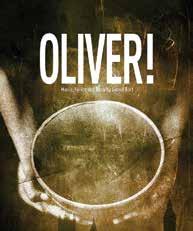
June 16 – July 9 // slolittletheatre.org


Head to Pismo Beach for a fun-filled weekend featuring the hottest classic cars where you will find like-minded aficionados from all over the state and the world.

June 16 -18 // theclassicatpismobeach.com

Thousands of people flock to downtown San Luis Obispo every Friday throughout the summer for a free, family-friendly concert in beautiful Mission Plaza.


June 9 – September 8 // downtownslo.com

Celebrating the
lakeside wine festival has grown to boast wineries, chefs, acclaimed artists, and live music.



June 24 // atascaderochamber.org



Since 1946, Blue’s Baseball has been a San Luis Obispo tradition. This family-friendly setting offers plenty of games and activities for the kids, as well as a concession stand and beer truck. The fireworks show will begin immediately following the game. July 3 // bluesbaseball.com

2017 marks the 48th year of the Brian Waterbury Memorial Rock to Pier Fun Run. This six-mile event is held entirely on the beach from Morro Rock to the Cayucos Pier and is open to participants of all ages and abilities. July 15 // morrobay.org


The annual Summer Music Festival features orchestra, chamber music, fringe concerts, notable encounters, family activities and other musical and social events for you to enjoy. July 19 – 30 // festivalmozaic.com

The Filipponi Ranch is once again hosting the Central Coast Shakespeare Festival. Pack a picnic and bring low-back chairs. Wine will be available for sale by the glass and bottle.

July 14 – August 5 // centralcoastshakespeare.org



The California Mid-State Fair is held annually and runs for twelve days at the end of July. The Fair has hosted some of the biggest names in the music industry.
July 19 - 30 // midstatefair.com





